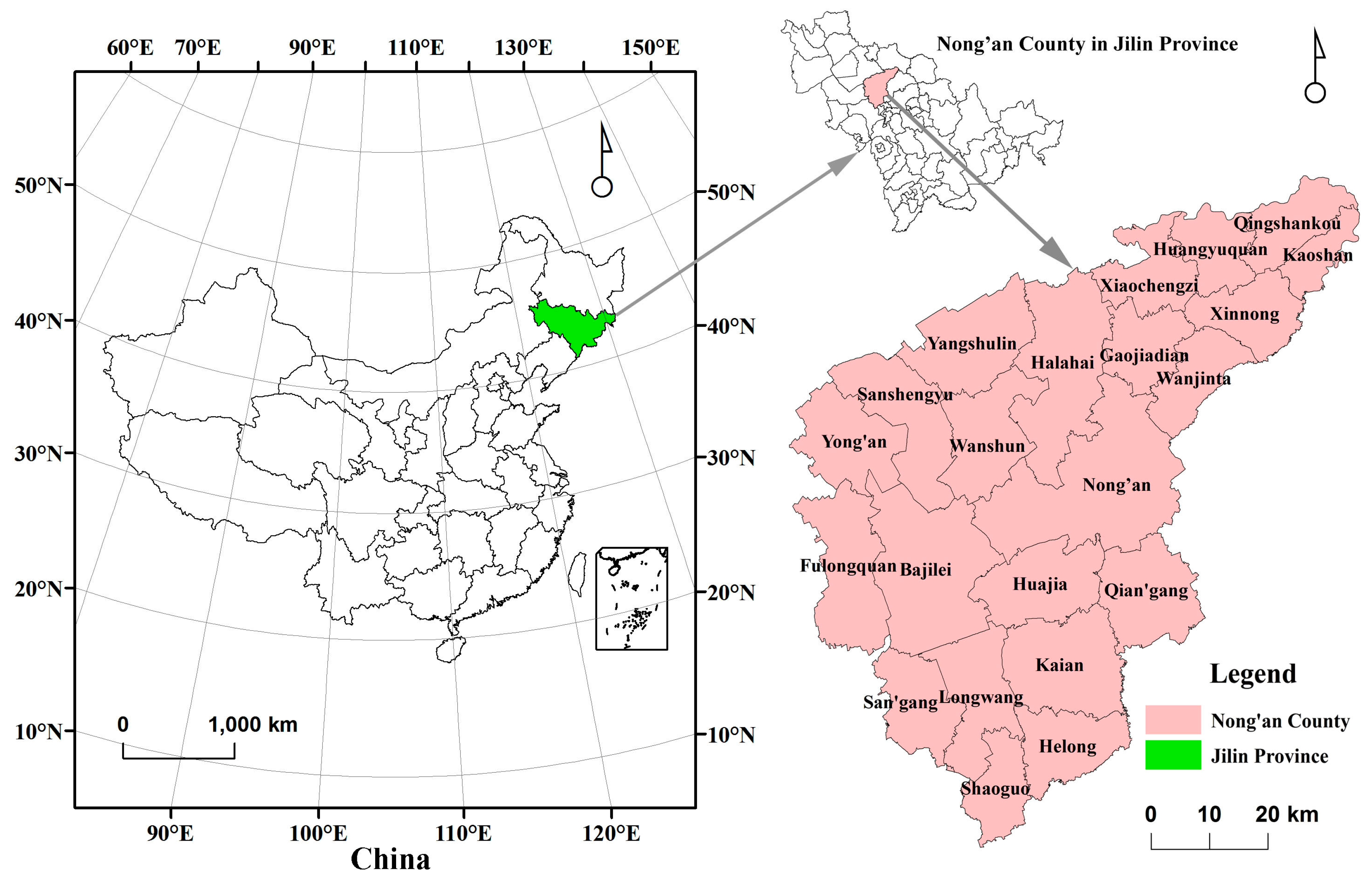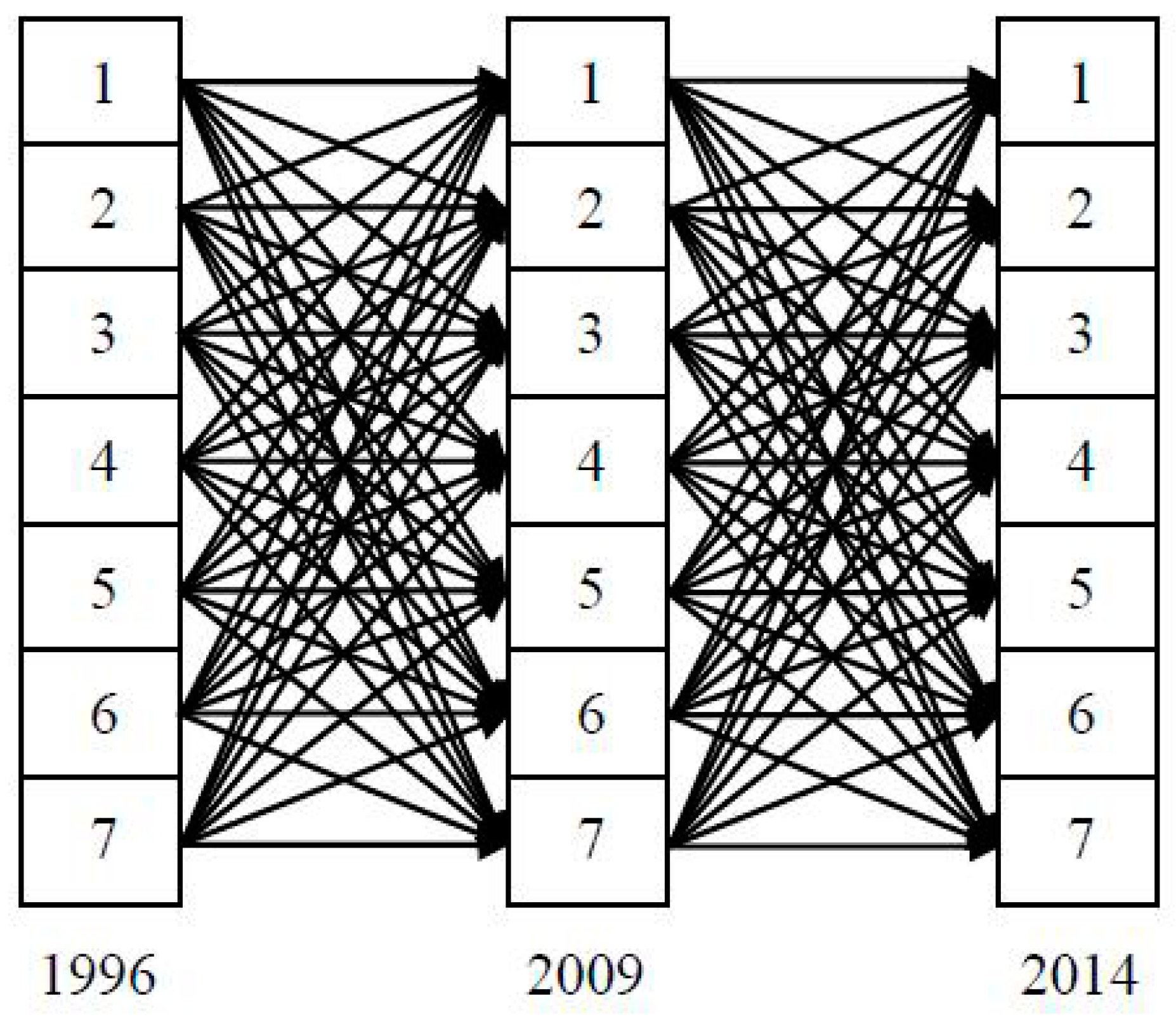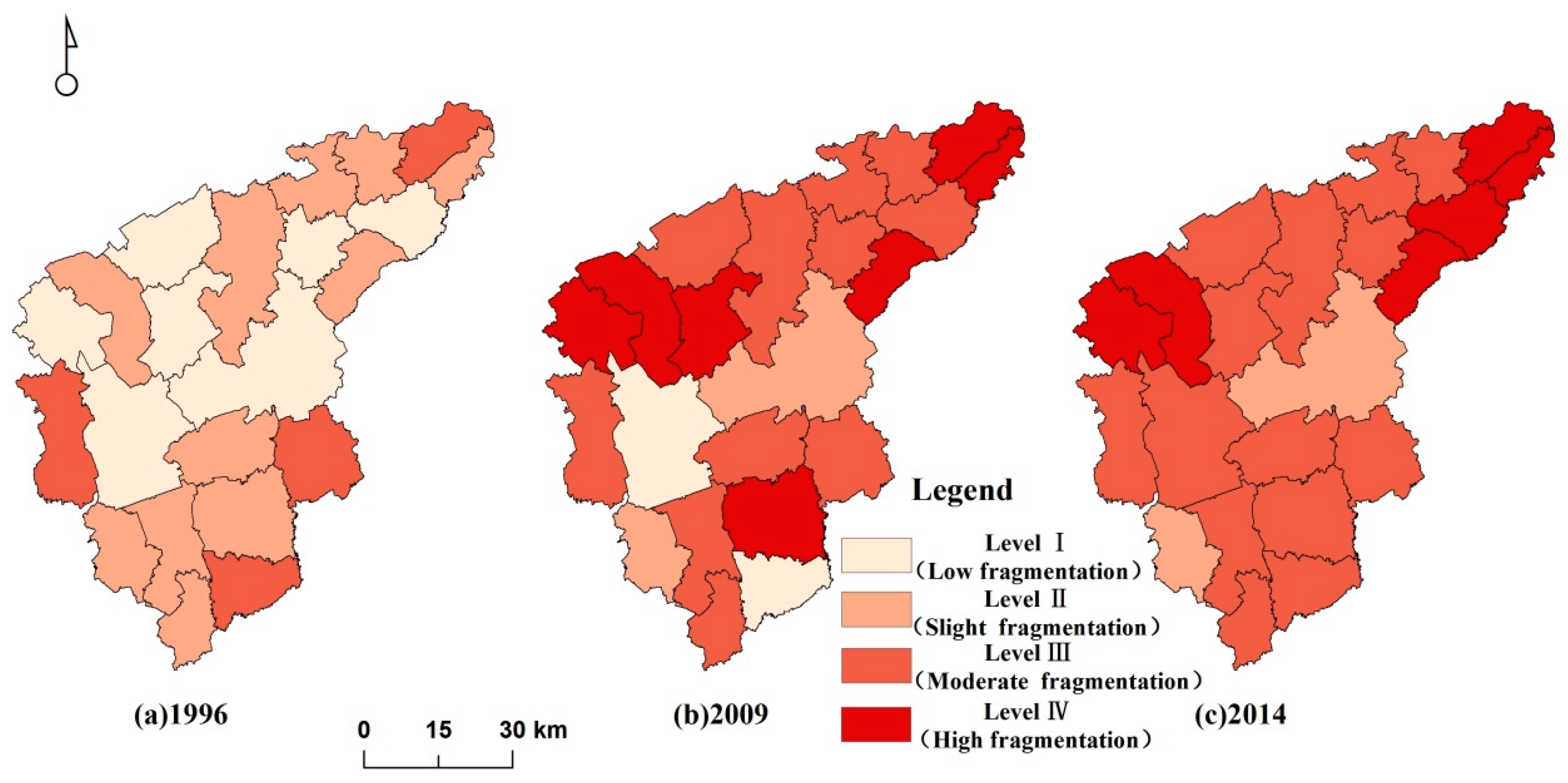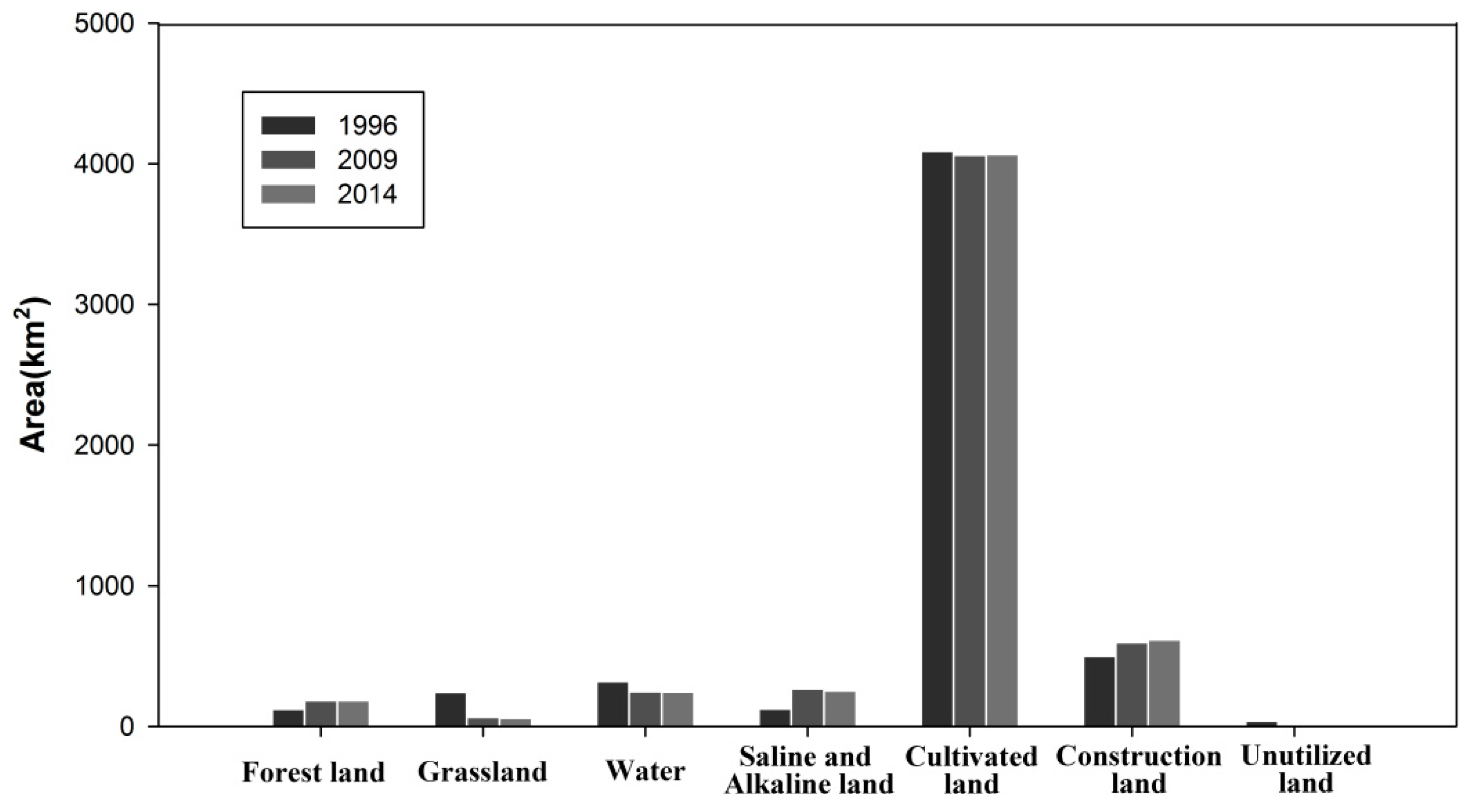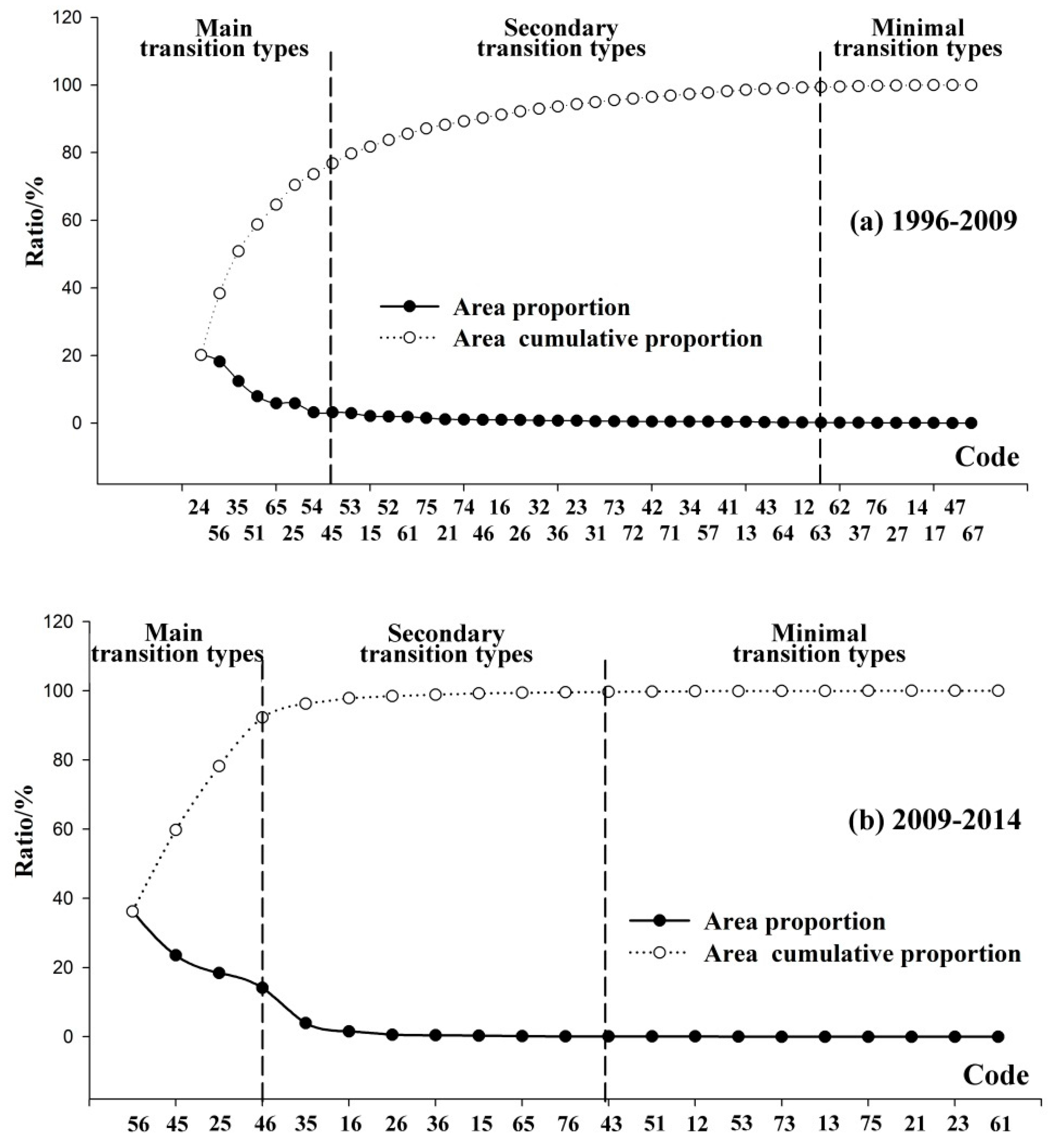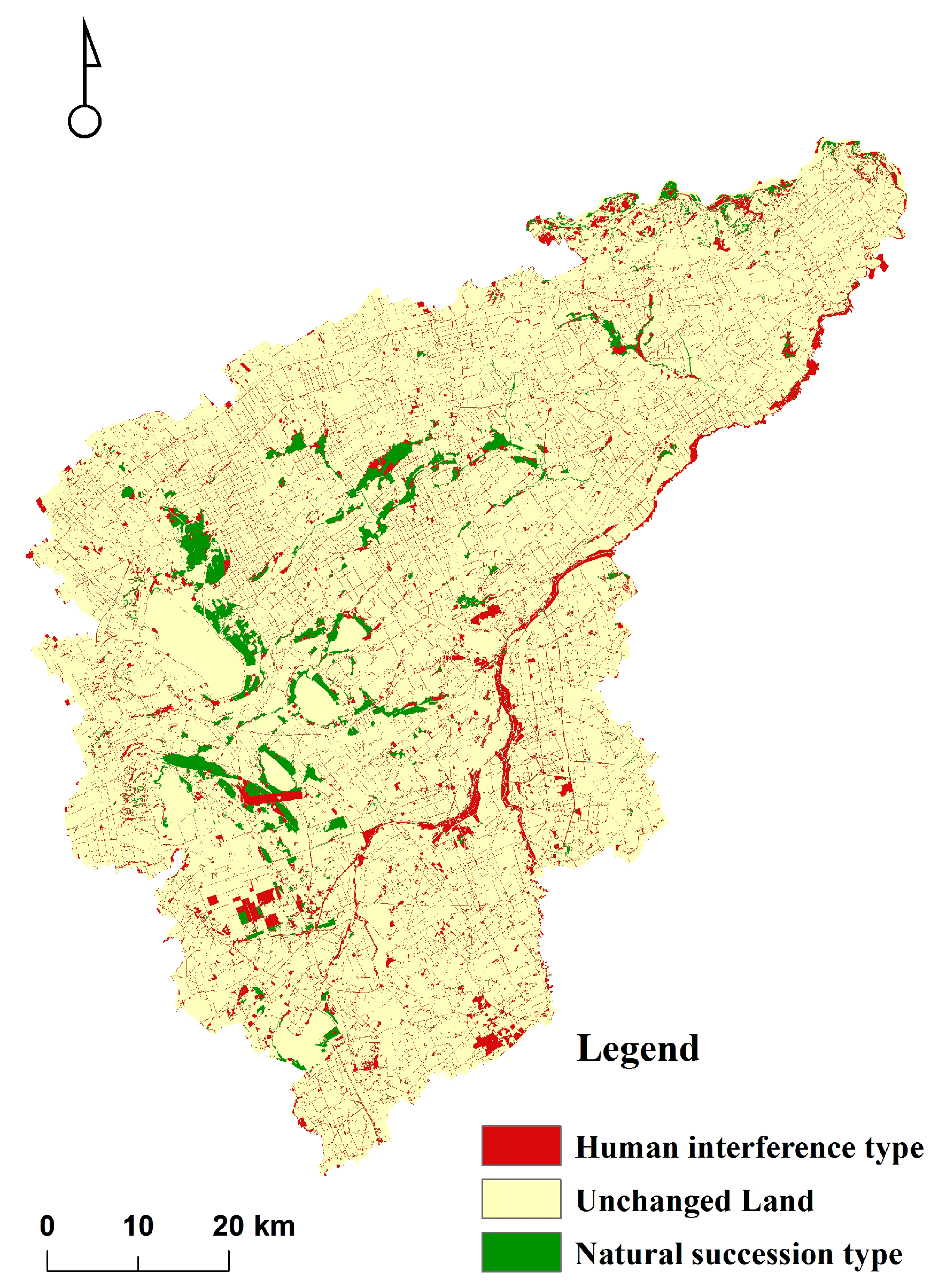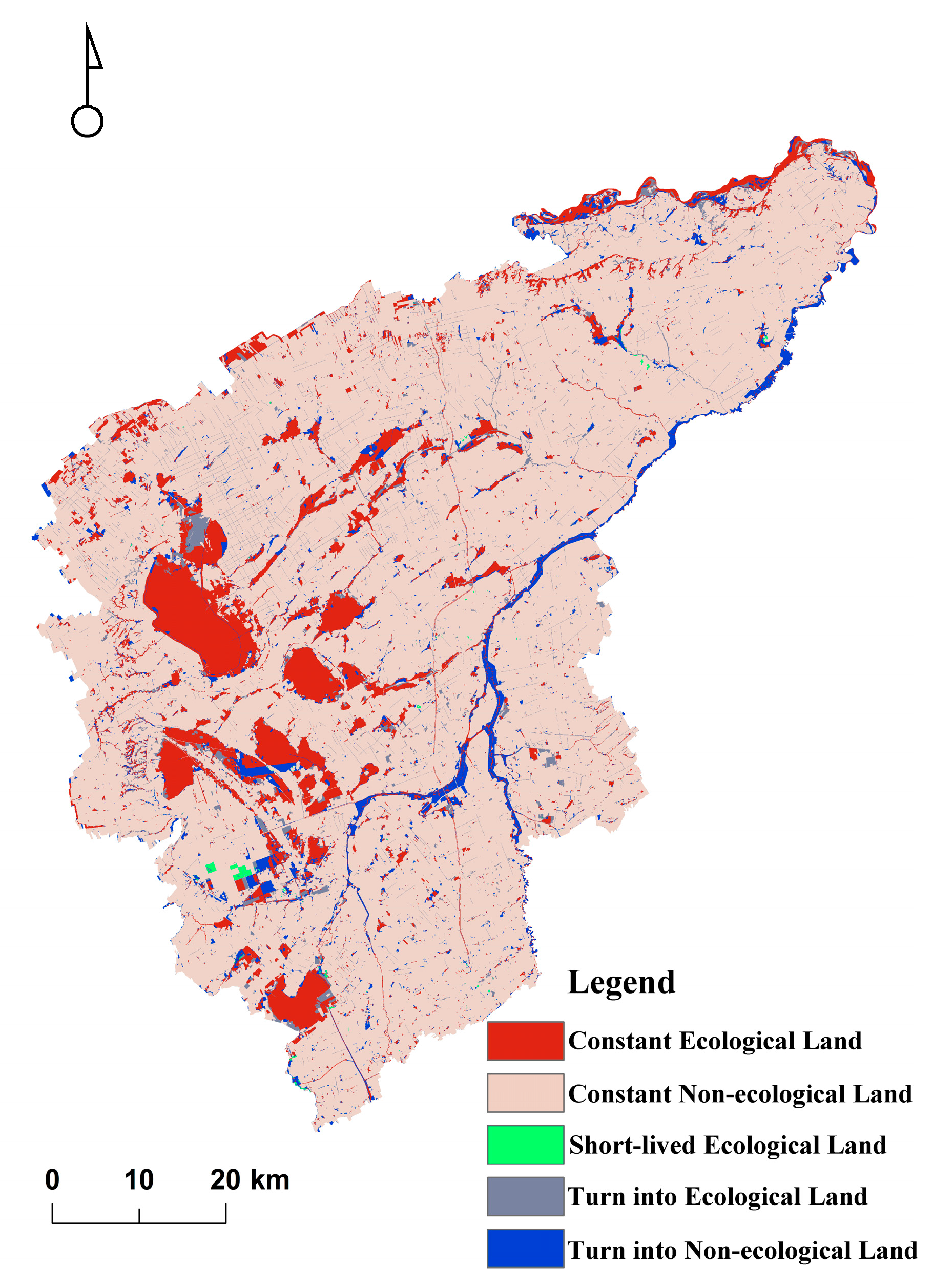1. Introduction
Rapid urbanization over the past 20 years in China has caused plenty of economic and social issues such as population explosion, built-up area expansion and environmental problems [
1,
2,
3,
4]. The interference of human activities has added more stress to natural habitats, which has directly affected the structure and function of the natural ecosystem and also caused ecological security problems in the form of environmental pollution, land degradation and a decrease in biodiversity [
5,
6,
7].
Land use and land cover change (LUCC) has been an important research project of land science and sustainable development. As a land use category with considerable ecological functions, ecological land has become the basic carrier of the land ecosystem service in regions with a series of ecological functions, including water and soil conservation, wind prevention, sand fixation, climate regulation and biodiversity maintenance [
8,
9,
10]. In addition, it also constitutes the matrix and connection among different land categories of the regional ecological landscape pattern and has direct impacts on social-economic-natural compound ecological system. The Quantitative measure of the ecological land use spatial pattern and land use changes is important to the comprehension of the regional land evolution and ecology security. However, limited by a land carrying capacity, irrational human production activities have occupied a large amount of ecological land and led to the increasing degree of land fragmentation, which will inevitably affect the regional-scale land use pattern [
11]. Land fragmentation is a specific form to describe the landscape evolution and a significant feature representing ecological security. It deeply influences the landscape ecological processes, such as biological diversity, energy flow and material cycle, and also shows effect on land use mode and environmental sustainable development [
12,
13,
14].
The traditional mode of studying ecological land mainly focused on analyzing landscape pattern succession and land cover change [
15,
16,
17,
18,
19,
20], measuring urban ecological land demand [
21], building landscape ecological security pattern [
22,
23] and land use changes in ecologically fragile areas [
24,
25,
26]. Lately, scholars have paid more attention to evaluating the landscape ecological security. In previous studies, Klijn presented a hierarchical approach to ecosystems classification and discussed the relation between the classification characteristics and spatio-temporal hierarchy of ecosystem components [
27]. Meng studied the dynamic changes of landscape connectivity for ecological land based on the graph theory and determined the distance appropriate landscape threshold [
28]. Zang constructed an ecological vulnerability assessment indicator system to conduct an empirical analysis of the changes in the spatio-temporal patterns, ecological vulnerability, and ecosystem services of typical landscape types [
29]. Su quantitatively explored the fragmentation features of ecological land and the relationships with urbanization scale and spatial configuration in the Yangtze River Delta [
30]. Peng reviewed the diverse connotations of ecological land from different perspectives and discussed the similarities and differences between ecological requirement and ecological land requirement. This study also proposed an ecological land requirement estimating system based on urban spatial and functional characteristics [
21]. Zhou identified ecological land by building ecological security patterns of different ecological processes and made appropriate references for urban ecological programming and spatial layout planning [
22].
The ecological significance of ecological land was well-know and has been widely discussed. However, the utilization value of ecological land for optimizing land use pattern and allocation has been ignored, and studies about land fragmentation were barely concerned to ecological land. A good understanding of ecological land fragmentation may not only help to figure out the ecological land use pattern but also provide basis information for policy making. In addition, further analysis of land use changes and internal transition relations can reflect the possible driving factors of land fragmentation. In view of the overall increasing land fragmentation, land policies such as land consolidation and the project of returning cultivated land to forest and grassland have been implemented to reduce the fragmentation. Along with the demanding requirement to land ecological protection, scientific measurement and analysis of driving factors for land fragmentation are the essential elements to make appropriate land use planning and policies. Black soil area is feasible for cultivation because of the fertile soil, nevertheless, the conflicts between land protection, ecological security and urban sprawl in this area has been increasing in recent decades. Ecological land in black soil area plays an important role in sustaining regional ecological environment and cultivated land quality. It is helpful to optimize land use pattern and maximize the use value of different land use types by understanding the ecological land fragmentation and land use changes.
In this study, we use Nong’an County as a case, which is a black soil farming area located in northeast China, to propose a landscape fragmentation evaluation model by selecting appropriate landscape indices from the aspects of area, shape and aggregation at county scale. Integrated measuring methods were chosen to detect land use dynamic changes and transition relations among different land use categories. The objectives of this study are: (1) to depict the spatial-temporal variations of the ecological land fragmentation and reveal the landscape evolution process in Nong’an County during 18 years; (2) to analyze the land use changes quantitatively and trace land transition trajectories by the methods of measuring land use dynamic degree and land use trajectory analysis; (3) to explore the possible driving factors of ecological land fragmentation comprehensively and propose appropriate suggestions for formulating land management policies and sustainable development. This study aims to provide a scientific evaluation model for measuring ecological land fragmentation, and figure out the regional land use transition relationships to offer suggestions for land planning and provide a practical case in a typical region.
4. Discussion
4.1. Spatial-Temporal Changes of Ecological Land Fragmentation and Land Use
4.1.1. Ecological Land Fragmentation Changes
There is an intensifying trend of ecological land fragmentation in Nong'an County from 1996 to 2014. The general growth of indices’ value from 1996 to 2009 was more rapid than that from 2009 to 2014. Spatial distribution characteristics indicated that fragmented region for ecological land expanded significantly during the 18 years, in particular the high-level fragmentation area.
4.1.2. Land Use Dynamic Changes
Ecological land consisted of four categories in this paper, which included forest land, grassland, water and saline-alkali land, to be analyzed with other land use categories. According to the results of the land use dynamic change degree and land use transition matrices, we could figure out that the ecological land decreased from 1996 to 2014 and that the internal categories changed more drastically than the ecological land itself. Grassland and saline-alkali land were the two major changed land use types during the study period, while grassland was mainly converted to saline-alkali land. Conversion between cultivated land, forest land and construction land also frequently occurred.
4.1.3. Land Transition Trajectories
There were a total of 119 land transition trajectory codes during the study period, which indicated frequent conversion of land use categories. Among which, unchanged land took a proportion of 86.46%, which was relatively stable. Human interference land and natural succession land took proportions of 9.42% and 4.12%, respectively. In addition, constant ecological land contributed a massive proportion in the processing of ecological land transitions, while the area of other land categories that became ecological land was less than that of ecological land that became non-ecological land.
4.2. Driving Factors of Ecological Land Fragmentation
Land use pattern changes were results of the combined actions of multiple elements, such as natural, economic and social factors. With the acceleration of urbanization, Nong’an County is facing severe conflicts between urban sprawl, cultivated land protection and grassland degeneration, which were actually conflicts of urban development, food security and ecological environmental protection.
4.2.1. Human Interference and Rapid Urbanization
The analysis of the land use change trajectories indicated that human interferences, especially cultivated land reclamation and urban sprawl, has become the chief factors of ecological land fragmentation. Furthermore, with the improvement of agricultural technology and benefit-tending of farmers to plant cash crops, farmers would actively cultivate some available ecological land as cultivated land or as garden plots. However, this scattered individual behaviour could only reclaim limited and decentralized cultivated land. Furthermore, it broke the pattern of concentrated ecological land and led to severe fragmentation. In terms of population, the nonagricultural population of Nong’an County increased from 170,123 to 220,579 during 1996 to 2014, while the growth rate was 29.66%. Population urbanization is the core of urbanization, which demonstrated rapid growth in rural settlements, built-up areas and towns. Driven by economic development and technological progress, the expansion of industrial land and the secondary and tertiary industry lands were also important factors in breaking the ecological land continuity.
4.2.2. Grassland Degeneration and Environmental Issues
The western region of Nong’an County is located in a farming-pastoral ecotone. During the study period, a large amount of grassland had degenerated into saline-alkali land, and this region suffered from many environmental issues, such as soil fertility decline, vegetation cover reduction and serious water and soil erosion. According to the spatial heterogeneity characteristics of Nong’an ecological land, the fragmentation pattern in the western region rapidly increased during each interval. Large-scale degradation of grassland broke the contiguous ecological land use pattern, and the ecological vulnerability of the land surface was further enhanced. However, due to the lack of investment and human interference factors, such as irrational land use and man-made activities, it has been much more difficult to manage degraded land. Ecological land fragmentation still showed a rapid increasing trend.
4.2.3. Land Use Policies
Land use policies are also uncertain external factors that affect land use patterns. Nong’an County is one of China’s major grain-producing counties. In the 1980s, relevant management policies mainly focused on cultivated land protection, while the attention to ecological land protection was relatively weak. Numerous ecological lands were damaged and irrationally used. The improvement of land policies and establishment of basic farmland protection area enormously improved the cultivated land quality and proportion, which inhibited the destructions of land reclamation in some ways. In later years, specific protection measures for ecological land were gradually issued and made certain effects. The results showed that the fragmentation degree had fallen down in some regions. The ecological land pattern improved from fragmentation and decentralization to concentration gradually and formed corridor connections among land categories in space. The ecological landscape pattern of Nong’an County tended to be more secure.
4.3. Suggestions for Formulating Land Management Policies and Sustainable Development
Fragmentation characteristics of ecological land can provide important basis for regional land use allocation and ecological protection. The calculation results of ecological land fragmentation level are conducive to implement the land use development strategy especially in spatial pattern, and the strategies can be made distinctively according to different fragmentation grades. For example, in the regions of low fragmentation and slight fragmentation, land use conditions are relatively stable while human interference makes a great influence on land use changes. In this study, we suggest to develop extra ecological land and construct the corridor connected with the high fragmentation regions on the premise of protecting existing concentrated ecological land, which can maximize the ecological value of land use. In moderate fragmentation regions, ecological land has been divided in some ways under the common influences of human interference and land natural succession. It would be effective to identify the area of ecological land with higher ecological value and to reduce the interference of human construction activities, which can directly increase the aggregation of ecological land. In high fragmentation regions, we propose a redevelopment strategy to increase the area of ecological land by cutting down some construction land and returning cultivated land. Therefore, the ecological function and utilization structure of ecological land should be recovered and reconstructed gradually.
The study results showed that human activities were highly correlated to land use fragmentation, the interferences mainly consisted of built-up area expansion and cultivated land reclamation. Restricting urban expansion strictly is beneficial to release extra ecological land and improve the pattern of ecological land. Furthermore, planning and allocating ecological land rationally are not only significant to embody the ecological value and use value of ecological land but also provide an optimization path for urban sustainable development.
5. Conclusions
In conclusion, ecological land in Nong’an County showed increasing fragmentation characteristics in spatial during the past 18 years due to severe human interference and land degradation. According to the results, ecological land decreased from 1996 to 2014 and the transition among land use categories was quite frequent. The conversion among ecological land, cultivated land and construction land occurred frequently, and human activities were still the dominant factor influencing the land use pattern. Under the common interactions of natural conditions and human activities, soil salinization and alkalinisation had caused issues, such as large amounts of grassland degradation and wetland subtraction in the western region of Nong’an County. In the late 1990s, modified land policies played a significant role in protecting ecological land, with decelerating fragmentation and the improvement of ecological landscape pattern.
The construction of ELLF model could indicate spatio-temporal changes of regional ecological land fragmentation and land use pattern. Moreover, it provided a scientific evaluation method for measuring land use fragmentation and laid a good foundation for appropriate policy-making to improve land use structure and land optimizing allocation. Land use dynamic changes described land use area changes and transition relationships among different land categories. In addition, the analysis of influence factors on ecological land fragmentation would be significant for regional ecological security of land ecological system. This study was also meaningful to reconcile the conflicts between economic development and ecological protection, and offer suggestions for land use planning and regional sustainable development.
